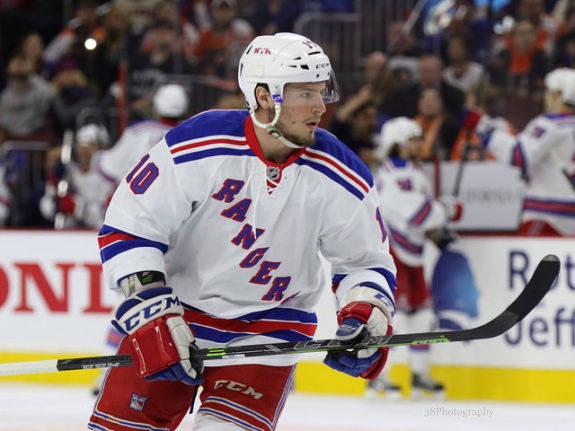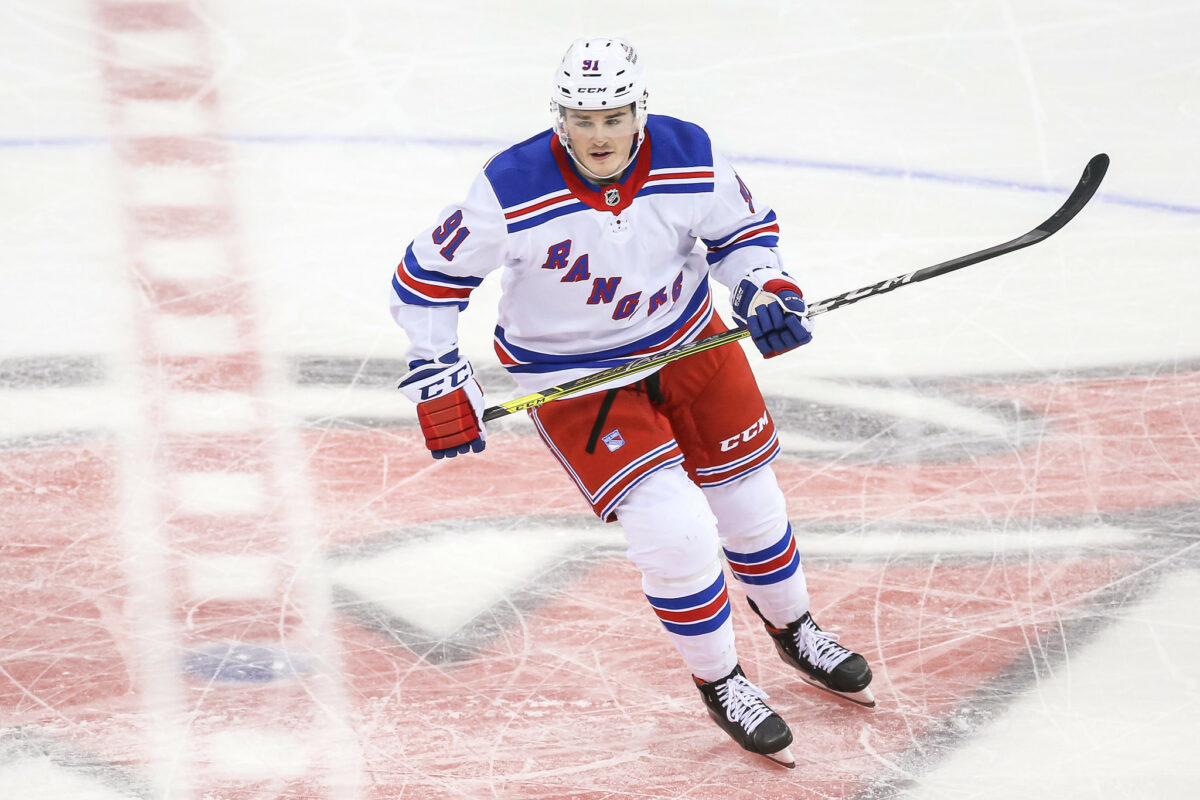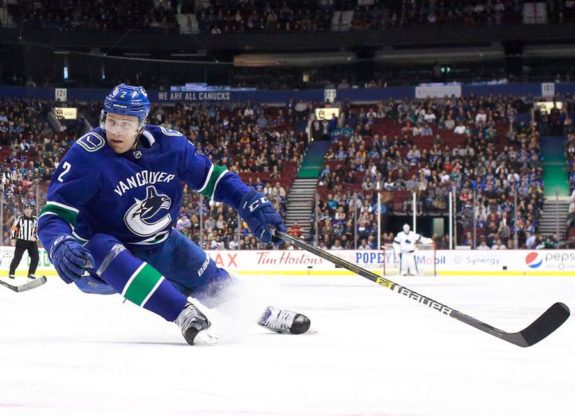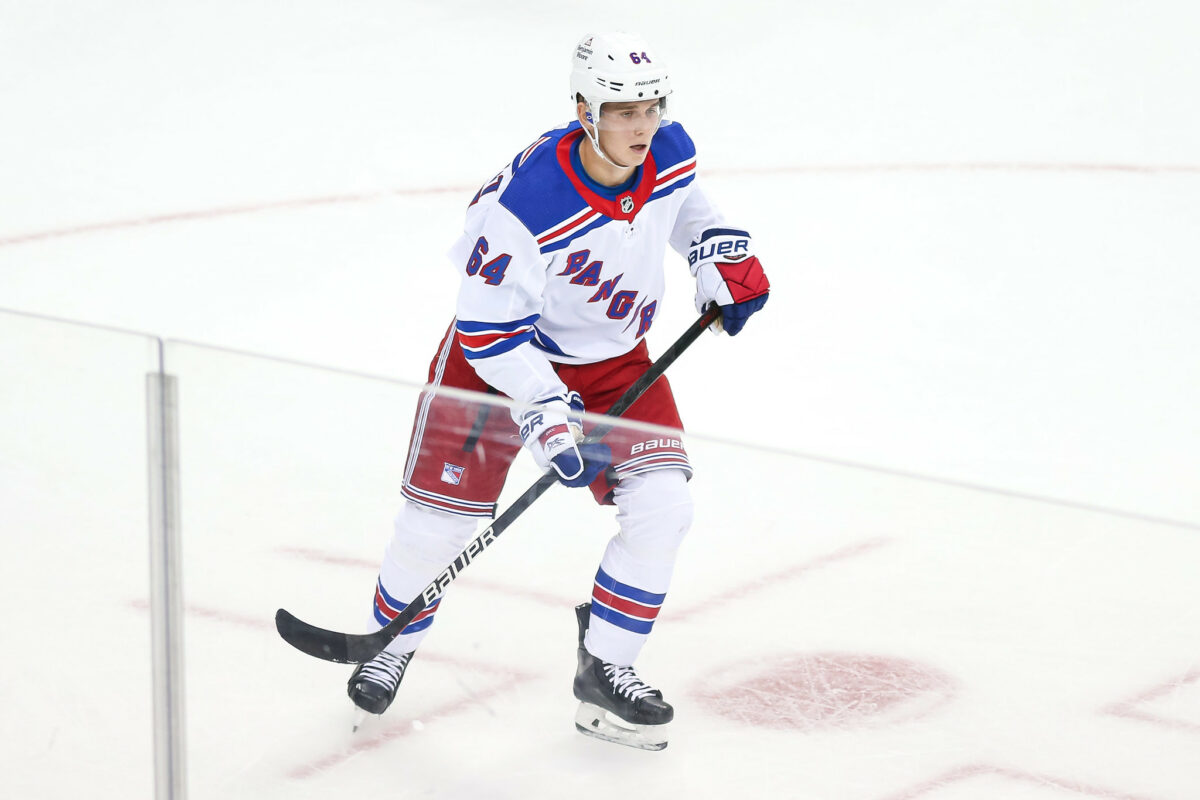The New York Rangers have gotten bigger and stronger this season. They’re playing a grittier, more physical game.
Unfortunately, they’re not big and strong enough, and their game isn’t as gritty or as physical as it needs to be to make a sustained playoff run.
How do we know this? Because when the Nashville Predators came to town Sunday and picked up a 1-0 victory, they showed the Rangers exactly what it’s going to take to grind out wins in the postseason – which proved to be more than the hosts currently have.
Amidst their mostly successful transition to a brawnier identity this season, the Blueshirts have often outhit opponents and succeeded in winning battles along the boards, down low and in front of the net. Yet the Predators were at a different level than the Rangers in the trenches, outhitting them 39-22, pushing them off the puck and mostly keeping the front of their net clear.

Vancouver Canucks forward J.T. Miller (Amy Irvin / The Hockey Writers)
Nashville won the one-on-one physical battles and largely kept the Blueshirts to the outside in the offensive zone. When the Rangers did manage to generate prime scoring chances in front, they weren’t sustained, with the Preds being conscientious in getting sticks into shooting lanes and clearing pucks and bodies away from the goalmouth, and Juuse Saros also came up big with 32 saves.
If the game didn’t qualify as a full-on wakeup call for the Rangers, it should nonetheless be instructive: They’ll inevitably face opponents in the postseason that play bigger and tougher than they do. More size and grit will be needed before the March 21 trade deadline, should the club extend its outstanding start to the season and find itself in playoff position then.
It’s why general manager Chris Drury needs to monitor the situation in western Canada, where the Vancouver Canucks might be moving out several very valuable pieces in exchange for futures, as their nearly $87 million cap number (made possible by Long-Term Injured Reserve) is fourth-highest in the NHL. That’s assuming, of course, that the Canucks’ current five-game winning streak, fashioned under new coach Bruce Boudreau, and 7-1-0 surge prove to be an anomaly and not a complete turnaround from their 6-14-2 stumble out of the gate.
Two of those pieces, forward J.T. Miller and defenseman Luke Schenn, should be on the Rangers’ radar from now until the deadline as perfect fits.
A Rangers Reunion With Miller Makes Perfect Sense
Miller’s story is well-documented: The Blueshirts’ first-round draft pick in 2011, 15th overall, was sent away in an ill-fated deadline deal with the Tampa Bay Lightning in 2018, the Rangers having grown frustrated with Miller’s inability to find consistency in his play after nearly six seasons on Broadway.
One stop after a season-plus in south Florida, Miller has developed into exactly the type of top-six forward his original NHL team thought he’d become. The 6-foot-1, 218-pounder has put up 147 points in 152 games in two-plus-seasons with the Canucks, and plays the type of power game that would make him such a perfect fit for the Rangers of 2021-22.

Miller with the Rangers in 2015 (Amy Irvin / The Hockey Writers)
Miller is big and strong, goes to the front of the net, skates well, takes the body and scores the kind of dirty goals that are so in demand in the playoffs. His rise is among the biggest reasons why the trade with the Lightning continues to haunt the Rangers – who have to take some responsibility for mismanaging his early development – nearly four years later (that, and the fact that the Blueshirts have yet to glean any real benefit at all from that lopsided swap).
Related: Lightning: Revisiting the McDonagh and Miller Trade
Miller, of course, won’t come cheap, should Vancouver inevitably decide to make him available. He’d be among the most sought-after commodities on the trade market ahead of the deadline, which should drive up the price. Nevertheless, the Rangers stand to benefit this season and beyond, should they be able to acquire him.
The Blueshirts performed well after an ugly first period in the loss to Nashville, often carrying the play for much of the final two periods. The defeat laid bare the aforementioned need for added physicality; it also brought into focus the Rangers’ thirst for reinforcements in their top six. Adding Miller would accomplish both.
Dryden Hunt has been a nice offseason addition, his sandpaper style and puck pursuit skills meshing well with the Rangers’ makeover, and he’s helped ease the loss of big winger Sammy Blais for the season. Yet Hunt isn’t nearly productive enough to be playing on one of the top forward units every night, and he’s not Blais, whose teeth-rattling body checks and strength along the walls and in front have been missed since he suffered a torn ACL against the New Jersey Devils on Nov. 14.

Rangers winger Sammy Blais, who’s out for the season (Jess Starr/The Hockey Writers)
Hunt, quite simply, is a bottom-six forward, someone who would fit much better on the Rangers’ formidable fourth line that consists of Barclay Goodrow, Kevin Rooney and Ryan Reaves. The Blueshirts have managed to navigate an unforeseen depth issue at right wing amidst their 19-7-3 start, but the current configuration isn’t a recipe for long-term success. Hunt is better as a depth player, not playing consistently on a line with Artemi Panarin and Ryan Strome – even if he does provide some of the dirty work required on that unit.
Injecting Miller, a much more offensively talented version of Blais, into the mix would do so much more for the Rangers than just adding another good player who hews to the heavy style the Rangers are continuing to adopt. It would allow them greater flexibility in constructing their optimum top two lines. Miller, who has generally been playing his natural center position the last two seasons but is also at home at right wing, could slot into Hunt’s spot with Panarin and Strome, giving the group a needed physical presence and a higher skill level than they are getting from Hunt.
If that doesn’t work, coach Gerard Gallant would have the option of returning Kaapo Kakko to the Panarin-Strome line, reuniting a trio that generally has performed very well this season, and bumping Miller to the right side of Zibanejad and Kreider. The latter combination would give the Rangers a muscular line featuring two power forwards who can skate and would make life very difficult for opposing defenders down low.
The ramifications of acquiring Miller have to be taken into account beyond this season. He isn’t a rental, with one more season at a $5.25 million cap hit remaining for 2022-23. Obtaining Miller – who does have a modified no-trade clause – almost certainly means the Rangers would have to bid goodbye to Strome this summer, as Panarin’s running mate is set to become an unrestricted free agent and is due a raise from his current $4.5 million hit. The Blueshirts simply don’t have the space to accommodate both of them, not with several key young players coming up for new contracts in the next few seasons.
Thanks to Miller’s versatility and excellent potential fit with these Rangers, though, the team wouldn’t be without options. Miller could slide into Strome’s spot next to Panarin as the easy replacement, likely even saving the club money for at least one season, with Strome expected to get a higher average annual value than Miller’s current number. There’s also third-line center Filip Chytil, who might finally be ready for more responsibility and could grab the assignment in the middle with Panarin, with Miller possibly joining them on the right. Miller’s also an excellent faceoff man, winning 52.3 percent of draws for his career – a sought-after skill on the Rangers, one of the most deficient teams in the NHL at the dots.
If the Blueshirts like what they see, there’s the option to try and extend Miller after next season, though that would be a decision for another time.
Adding Schenn Would Beef Up a Defense in Need of Size, Physicality
While Miller would fulfill the pressing need for heavy reinforcements up front, the Rangers are also lacking the same key element on defense. Despite the full emergence of Jacob Trouba’s nasty edge this season, there’s not nearly enough snarl and strength on the back line. Ryan Lindgren plays a tough game, but at 6-1 and 191 pounds, he’s not able to physically dominate. Patrik Nemeth, signed for his 6-4, 230-pound frame and supposed ability to keep the crease clear, has played small and shown little of the pushback the Rangers thought they were getting. K’Andre Miller is 6-4 and 216 pounds, but his considerable talents don’t include much in the way of physicality.
The Rangers’ current third defense pair consists of Nemeth and promising rookie Nils Lundkvist, an arrangement that isn’t working. Gallant’s modus operandi has been to sit the smallish Lundkvist for the second half of third periods, rotating players into that spot regardless of the score.
That’s not a viable long-term approach. And it’s why, while the Rangers are shopping the Canucks’ roster for a high-end forward, they should also hit the bargain aisle and see if they can add defenseman Luke Schenn to the cart.

Canucks defenseman Luke Schenn (Photo by Jeff Vinnick/NHLI via Getty Images)
Schenn is a 6-2, 226-pound right-handed shot who plays a throwback game. The 14-year veteran piles up hits and pushes opposing forwards around and would make other teams instantly less comfortable in the Rangers’ zone. The 32-year-old won Stanley Cups with the Tampa Bay Lightning the past two seasons and is signed for next season at $850,000. He’s posted a plus-6 rating and recorded 58 hits in 15 games this season.
So the fact that Schenn is paid cheaply will ironically, in all likelihood, make him more expensive. He’ll also probably be in demand at the deadline, though not at Miller’s level.
Acquiring Miller and Schenn Would Be Costly, but Worthwhile
So what would the Rangers have to give up to bring both players, such perfect puzzle pieces for them, to Broadway? It’s of course hard to say without the market established at this point. The price, though, should be steep in any scenario. So some pure speculation on a starting point – some combination of the Blueshirts’ 2022 first-round pick, the 2022 second-round pick obtained in the Blais trade with the St. Louis Blues last summer and perhaps Lundkvist (ironically taken with the first-round pick the Rangers got from the Lightning in the 2018 trade for Miller and Ryan McDonagh) or defense prospect Zac Jones. Disgruntled but talented forward prospect Vitali Kravtsov could enter the conversation, although Drury has stated that he’s determined to get equal value for the ninth overall pick in the 2018 draft.
Yes, pricey. That’s generally the cost of doing business at the trade deadline. Yet if the Rangers continue to play well and find themselves solidly in playoff position, what else should they do? Claim they’re still in a rebuild and not ready to sacrifice the youth accumulated over what will be a four-year project at that point?

Rangers rookie defenseman Nils Lundkvist (Jess Starr/The Hockey Writers)
Such an argument seems nonsensical. Four of the Rangers’ top players – Panarin, Trouba, Zibanejad and Kreider – are in their prime now in their late 20s or early 30s, unlikely to get better as their expensive contracts age. The Blueshirts have Norris Trophy-winning defenseman Adam Fox and goaltender Igor Shesterkin, who was playing like a Vezina Trophy contender before getting injured (he’s close to returning). They’ll have all the cap space they need to add players at the deadline.
And their trove of prospects – especially on defense – is going to have to be thinned at some point, because everyone can’t make the NHL roster. Lundkvist and Jones are highly regarded youngsters, but both are small, puck-moving blueliners who will always need to be paired with a physical stay-at-home type. It’s hard to imagine a scenario where the Rangers could have Fox, Lundkvist and Jones playing regularly for the same defense corps. There just wouldn’t be enough size and strength to protect the net and win battles in the defensive zone, so trading Lundkvist or Jones seems like a painful inevitability.
Should the Rangers be a good probability to make the postseason in late March, this is the kind of trade they should look to execute. A package deal for Miller and Schenn would be exactly what they require to fortify for a playoff run, and both players would fit the team’s plans beyond this season.
With top players in their prime, the cap space to make a big move, plenty of appealing trade capital and high-end young players who could be ready for a breakout as the season progresses, there’s every reason for the Blueshirts to act boldly to make such a deal with the Canucks happen – if, of course, they’re finally looking like clear playoff contenders once again.
